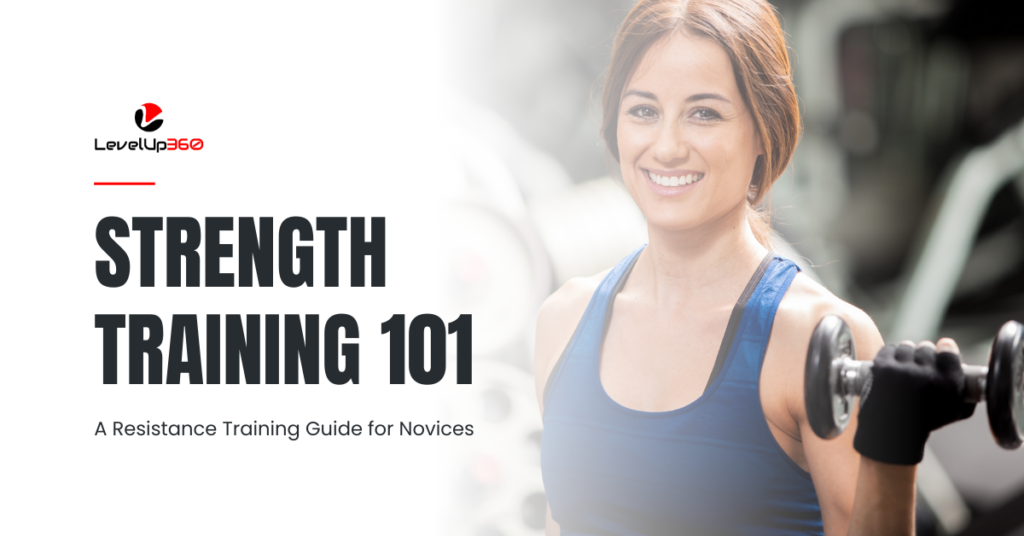
Strength Training 101: A Resistance Training Guide for Novices
Strength training is an effective way to build muscle, get stronger, improve health, and feel more confident. But as a beginner, getting started with programming can seem intimidating. This extensive guide covers everything you need to know to start strength training properly on your own.
We’ll dive deep into:
- Key strength training terms and concepts
- Determining optimal training frequency and volume
- Exercise selection and perfecting technique
- Customising programming based on your goals
- Progressive overload principles
- Sample beginner programs and splits
- Knowing when to train to failure
- Important nutrition and recovery basics
- Strategies for consistency and motivation
Let’s get started!
Learning to intensely focus on the target muscles during training can significantly enhance your results. This mind-muscle connection helps ensure the muscles work maximally through the full range of motion
Key Strength Training Terms and Concepts
First, let’s define some key terms that will provide context for program design:
- Exercise – A specific movement or exercise, like a squat, deadlift, or bicep curl.
- Set – A group of consecutive repetitions of one exercise. For example, 3 sets of 10 squats mean performing 10 squats continuously, resting, and repeating for 3 total sets.
- Reps – The number of times you complete the movement in one set. If you squat 10 times in a row within a set, that’s 10 reps.
- Volume – The total number of reps x sets per exercise and muscle group. Volume is a major driver of muscle growth.
- Intensity – How heavy the weight is relative to your capability. Heavier weights mean higher intensity.
- Frequency – How often you train each muscle group per week. Most muscle groups can be trained 2-3x per week for a beginner.
- Progressive Overload – The gradual increase in volume, intensity, and/or frequency over time to continually challenge your body. This drives strength and muscle gains.
- 1 Rep Max (1RM) – The maximum amount of weight you can lift in an exercise for one repetition with proper form. Knowing your 1RM helps select training loads.
- Rest Periods – The time you rest between sets to recover and lift optimally on the next set. Shorter rest periods like 60 seconds are best for muscle growth, while 3-5 minutes are better for developing maximal strength.
Choosing Training Frequency and Overall Volume
A good general recommendation for beginners is to do full-body workouts 3 days per week. This allows training each muscle group frequently enough to spur growth. You can consider splitting into upper and lower body training 4 days per week after building more experience.
Start with just 2-4 sets per exercise, keeping most sets in the 8-15 rep range. This equates to ~16-24 total sets per workout for the major compound lifts. Research has shown this modest volume provides excellent returns on strength and size gains in novices while managing fatigue.
You can gradually add sets over time as your work capacity improves and work on lower rep ranges and higher intensities as your technique improves. But, as a beginner, avoid drastically increasing volume too quickly to avoid excessive fatigue or working at low rep ranges and higher intensities when you are still not mastering exercise techniques to avoid injury risk. Give your body time to adapt to greater demands.
Mastering Exercise Technique
As a beginner, perfecting exercise technique should be the top priority with all lifts before worrying about adding weight. Proper technique puts you in the safest, strongest position for each lift, allowing you to progress over time without injury.
When first learning compound barbell lifts like the squat or bench press, consider hiring a qualified trainer for at least a few sessions. A trainer can correct form flaws early before they become ingrained habits.
If training alone, frequently film yourself performing the lifts and compare them to online tutorials to match ideal positioning. A caveat here – not everyone performs exercises exactly alike since biomechanics vary from person to person. The key is ensuring you target the right muscle groups and perform the movement within your own range of motion with good technique.
Common technique mistakes like squatting too shallow, arching excessively on the bench, or rounding the back on deadlifts can impede progress and lead to injury if not fixed. Early form checks are critical.
Programming Based on Goals

Novice lifters looking to simply gain well-rounded strength and muscle should stick to mostly compound lifts like squats, presses, pulldowns, and rows. Isolation exercises for smaller muscle groups can be incorporated but aren’t essential early on.
If interested in a specific sport like powerlifting or focusing on physique, you can include more specific exercises but maintain a foundation of heavy compound lifting. For example, a powerlifter may incorporate extra bench press variations while a physique-focused lifter adds more biceps and triceps work.
But as a general guideline, the bulk of your routine as a novice should consist of mastering major compound lifts that train multiple large muscle groups at once. This builds overall strength to support gains while keeping training time efficient.
Principles for Proper Progression
To keep improving over time, you must gradually increase the demands through progressive overload techniques:
- Increase weight lifted: The most straightforward approach. For example, add 2.5kg (5.5 lbs) each session to compound lifts like the squat or bench press when you hit the target repetitions in all sets.
- Add reps: You can stick at the same weight but complete more reps before increasing the load, such as progressing from 3×8 to 3×10.
- Increase volume via added sets: Adding a 4th set over time is an easy way to progress volume for greater gains.
- Increase training frequency: You might start bench pressing just once per week, then eventually bench twice per week for faster strength gains.
- Modulate intensity: Periodise training by cycling heavy and light days or high and low rep ranges to allow for manageability.
Add these overload elements slowly over several weeks or months. Adding many variables simultaneously can quickly lead to overtraining as a novice.
How Fast Should You Lift? Tempo and Time Under Tension
An additional variable for programming is tempo, or the speed at which you perform each rep. Tempo allows manipulation of time under tension for different training effects. Time under tension refers to how many seconds your muscles are contracted during each set.
Some common tempos are:
- Traditional (2-0-2) – 2 seconds lowering, no pause, 2 seconds raising
- Slow/TUT (4-0-4) – Great for muscle damage and hypertrophy
- Fast/Explosive (1-0-1) – Develops power and mimics athletic motions
- Paused (3-2-1) – Increases difficulty and time under load
Play with different tempos but keep most of your training in the traditional 2-0-2 range as a novice. Occasionally incorporate slower speeds for extra hypertrophy or explosive moves for power.
Mastering the Mind-Muscle Connection
Learning to intensely focus on the target muscles during training can significantly enhance your results. This mind-muscle connection helps ensure the muscles work maximally through the full range of motion.
In my experience, mind-muscle connection has better application to isolation exercises than heavy compound lifts, however, it can also help novices solidify good technique when first learning compound movements.
Here are some tips to improve mind-muscle activation:
- Visualise the muscle contracting during lifts
- Focus on feeling the target muscles working
- Use lighter weights to isolate muscle contractions
- Squeeze muscles hard at the top of the movement
- Perform drop sets or partial reps to keep tension on muscles
- Hold peak contractions for 1-2 seconds
With practice, you’ll be able to better activate specific muscles during training for full development.
Knowing When to Go to Failure
Training to the point of momentary muscular failure, or the inability to complete another proper rep, is a method to maximise intensity. But should going to failure be standard in your programming?
Research shows that training to failure is effective for hypertrophy, but not necessary for all lifts. Consider going close to failure on isolation lifts like leg curls or tricep pushdowns but avoiding it on big compound moves like squats or deadlifts where injury risk increases when form breaks down.
On key heavy compound lifts, leave 1-2 reps in reserve (RIR) on your sets rather than pushing to failure. Going to failure may benefit hypertrophy but risks overuse injuries and central nervous system fatigue.
Use failure occasionally but not for every set. Limit failure training to isolation lifts or higher rep sets like 12-15 reps where risk is lower. Failure provides an intense stimulus but requires a longer recovery.
Strategic use of training to failure provides benefits but understand the trade-offs. Avoid pushing past technical failure where form falters.
Nutrition and Recovery for Beginners

Proper post-workout nutrition and rest are key for maximising beginner strength and muscle gains:
- Consume 30-40g of protein post-workout to facilitate muscle protein synthesis.
- Refuel muscle glycogen stores within 1-2 hours after training by eating carbohydrate-rich foods like fruit, rice, potatoes…
- Allow at least 48 hours before training the same major muscle group again to allow for tissue repair and recovery. Muscles grow during rest.
- Take 5-10g of creatine daily to increase recovery from training.
- Prioritize sleep by getting 7-9 hours per night consistently for optimal recovery. Lack of sleep disrupts anabolic hormones.
Simple consistency is key – don’t allow nutrition or recovery practices to falter for best results from the training itself.
Preventing and Managing Injuries
As a novice, focus extensively on perfect exercise technique before progressing to heavier weights. Proper form reduces injury risk.
Progress load and volume conservatively. Only increase volume when you can recover well between sessions.
Avoid training through sharp, acute pain. Soreness can be trained through, but sharp pain during lifts often indicates injury.
Manage minor aches with RICE – rest, ice, compression, elevation. Seek professional help for any severe or lingering pain.
Consider wraps, braces, and belts only if cleared by a physician or for heavy lifts. Do not rely on braces to compensate for poor form.
Prioritise mobility work and corrective exercises if you have muscle imbalances or movement restrictions. Ensure joints have full range of motion.
Sample Beginner Strength Training Program
I have put together 3 sample workout routines (to cater for different people with access to different pieces of equipment) tailored for a novice trainee (< 3 years of lifting experience) who has a goal to improve overall health and wellness.
Sample Beginner Strength Training Program
Bodyweight and Resistance Bands
Day 1:
- Bodyweight/Banded Squat: 4 sets of 10 reps
- Push-Up: 4 sets of 10 reps
- Resistance Band Assisted Pull-Up: 3 sets of 10 reps
- Resistance Band Shrug: 3 sets of 12-15 reps
Day 2:
- Resistance Band Deadlift: 4 sets of 10 reps
- Resistance Band Overhead Press: 4 sets of 10 reps
- Resistance Band Row: 3 sets of 10 reps
- Resistance Band Upright Row: 3 sets of 12-15 reps
Day 3 (only if not sore and recovering well from Day 2):
- Single-leg Glute Bridge: 3 sets of 10 reps per leg
- Bodyweight/Resistance Band Rear Foot Elevated Split Squat: 3 sets of 12-15 reps per leg
- Incline Push-Up (elevate your hands): 3 sets of 10 reps
- Resistance Band Row (attach band to a sturdy anchor): 3 sets of 12-15 reps
- Lateral Raise (with resistance bands): 3 sets of 12-15 reps
Dumbbells
Day 1:
- Dumbbell Goblet Squat: 3 sets of 8-10 reps
- Dumbbell Bench Press: 3 sets of 8-10 reps
- Dumbbell Row: 3 sets of 8-10 reps per arm
- Dumbbell Shrug: 3 sets of 12-15 reps
Day 2:
- Dumbbell Deadlift: 3 sets of 8-10 reps
- Dumbbell Overhead Press: 3 sets of 8-10 reps
- Dumbbell Row: 3 sets of 8-10 reps per arm
- Dumbbell Shrug: 3 sets of 12-15 reps
Day 3 (only if not sore and recovering well from Day 2):
- Dumbbell Romanian Deadlift: 3 sets of 8-10 reps
- Bulgarian Split Squat: sets of 10-12 reps per leg
- Dumbbell Incline Bench Press: 3 sets of 8-10 reps
- Dumbbell Row: 3 sets of 8-10 reps per arm
- Dumbbell Lateral Raise: 3 sets of 10-12 reps
Full Gym Access
Day 1:
- Barbell Back Squat: 3 sets of 8-12 reps
- Bench Press: 3 sets of 8-12 reps
- Assisted Pull-up: 3 sets of MAX reps
- Dumbbell Shrug: 3 sets of 12-15 reps
Day 2:
- Barbell Deadlift: 4 sets of 5 reps
- Overhead Press: 3 sets of 8-12 reps
- Seated Row: 3 sets of 8-12 reps
- Dumbbell Shrug: 3 sets of 8-12-6 reps
Day 3 (only if not sore and recovering well from Day 2):
- Romanian Deadlift: 3 sets of 8-12 reps
- Dumbbell Lunge/Bulgarian Split Squat: 3 sets of 8-10 reps
- Incline Dumbbell Bench Press: 3 sets of 8-12 reps
- One Arm Dumbbell Row: 3 sets of 8-10 reps
- Dumbbell Lateral Raise: 3 sets of 10-12 reps
Consistency and Motivation for Beginners
The most crucial components for a novice are consistency with training and nutrition. Motivation inevitably declines after the eager beginner phase. Some strategies to maintain adherence include:
- Start very gradually – just 2-3 basic lifts per session 2-3x weekly to build a habit before expanding volume or frequency.
- Focus on completing planned workouts rather than chasing new maximums each session.
- Track workouts and progression in a journal to see progress over time.
- Follow a structured program rather than randomly choosing exercises to promote orderly progress.
- Find an accountability partner or hire online coaching if motivation wanes.
- Set specific, achievable goals like “Deadlift 225 lbs” or “Add 2.5 lbs to squat each week” to measure progress.
- Take before/after photos monthly and log body weight to quantify changes.
- Compete only against your past self rather than comparing to others.
Consistency is key. With dedication and persistence in following the basics, major strength and muscle gains are achievable within the first year of proper training and nutrition as a novice. While your genetic potential will dictate your ultimate ceiling, most beginners can gain 20-265 pounds (9-11 kg) of muscle in the first year of serious strength training.
Some key tips to maximise beginner gains:
- Follow a program without overanalysing daily changes in strength or physique. Trust the process.
- Progress load conservatively before pushing closer to muscular failure. Leave 1-2 RIR for compound lifts.
- Get sufficient protein daily – 0.7 to 0.1 grams per pound (1.5-2.2g of protein per kg) of lean body mass – to facilitate growth.
- Take advantage of “newbie gains” by strategic bulking – aim to gain 0.5-1 pound per week.
- Sleep at least 7-9 hours per night consistently for optimal recovery.
- Stick to the major compound lifts before adding isolation volume.
- Film key lifts frequently and compare to tutorials to ensure good form.
Follow a program for 8-12 weeks before changing variables to allow progressive overload.
In summary, as a beginner focus on consistency, gradual progress, and dialling in proper technique on the big basic barbell lifts. Be patient through plateaus and keep challenging yourself as you advance. Building a proper foundation now will pay dividends for years to come on your lifting journey.
Recommended reading
Recommended reading
Additional Resources
Feeling in control of your health
If you are interested in improving your health and wellness, check out other resources such as Our Blog, Free Resources and/or join our private Body-Mind Transformation Secrets Community on Facebook, and go on an even deeper dive with me to uncover how to succeed in your health and wellness goals.
You may also be interested in our Sleep Secrets Cheat Sheet. It is a great resource with strategies to fix and optimize your sleep which is crucial to succeeding in your health and wellness goals.
Resources
Pictures








